Phalaenopsis
| Phalaenopsis | |
|---|---|
 | |
| Closeup of a Phalaenopsis flower | |
| Scientific classification | |
| Kingdom: | Plantae |
| (unranked): | Angiosperms |
| (unranked): | Monocots |
| Order: | Asparagales |
| Family: | Orchidaceae |
| Subfamily: | Epidendroideae |
| Tribe: | Vandeae |
| Subtribe: | Aeridinae |
| Alliance: | Phalaenopsis Blume |
| Genus: | Phalaenopsis Blume 1825 |
| Type species | |
| Phalaenopsis amabilis Blume (1825) | |
| Synonyms[1] | |
| |
Phalaenopsis /ˌfælɪˈnɒpsɪs/ Blume (1825), known as moth orchids, abbreviated Phal in the horticultural trade,[2] is an orchid genus of approximately 60 species. Phalaenopsis is one of the most popular orchids in the trade, through the development of many artificial hybrids. It is native to southern China, Taiwan, the Indian Subcontinent, Southeast Asia (Thailand, Philippines, Malaysia, Indonesia, etc.), New Guinea, the Bismarck Archipelago, and Queensland.[1][3]
Description
The generic name from Greek means φαλαινα "Phalaen[a]-like" and is probably a reference to the genus Phalaena, the name given by Carl Linnaeus to a group of large moths; the flowers of some species supposedly resemble moths in flight.[4] For this reason, the species are sometimes called moth orchids.
They are native throughout southeast Asia from the Himalayan mountains to the islands of Polillo, Palawan and Zamboanga del Norte in the island of Mindanao in the Philippines and northern Australia. Orchid Island of Taiwan is named after this genus. Little recent information about their habitat and their ecology in nature is available since little field research has been done in the last decades.
Most are epiphytic shade plants; a few are lithophytes.[5] In the wild, some species grow below the canopies of moist and humid lowland forests, protected against direct sunlight; others grow in seasonally dry or cool environments. The species have adapted individually to these three habitats.
Possessing neither pseudobulbs nor rhizome, Phalaenopsis shows a monopodial growth habit: a single growing stem produces one or two alternate, thick, fleshy, elliptical leaves a year from the top while the older, basal leaves drop off at the same rate. If very healthy, a Phalaenopsis plant can have up to ten or more leaves. The inflorescence, either a raceme or panicle, appears from the stem between the leaves. They bloom in their full glory for several weeks. If kept in the home, the flowers may last two to three months after which a Phalaenopsis Orchid will need to conserve energy for further leaf, bud and root development.[6]
Some Phalaenopsis species in Malaysia are known to use subtle weather cues to coordinate mass flowering.
Classification
The genus can be classified into two groups :
- A group of species with a long, branched inflorescence (up to 1 m long) and large, almost round flowers with rose or white tints.
- A group of species with short stems and less rounded, waxy flowers with more pronounced colors.
In terms of Raunkiær plant lifeform terminology, these plants are epiphytes.
Based on DNA evidence, the genera Doritis Lindl. and Kingidium P.F.Hunt are now included in Phalaenopsis, according to the World Checklist of Selected Plant Families.[7] However, not every specialist in this field accepts these taxonomic changes.
Intensive cross-fertilization has produced a great number of hybrids in all colors and variations. These are usually more adaptable to artificial conditions than their botanical ancestors. Many are hybrids of Phalaenopsis amabilis, Phalaenopsis schilleriana or Phalaenopsis stuartiana.
Species
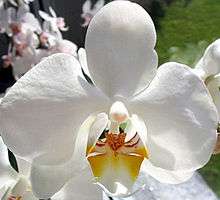

- Phalaenopsis amabilis (Moon Orchid; East Malaysia to Papuasia)
- Phalaenopsis amabilis subsp. amabilis (East Malaysia to Papuasia).
- Phalaenopsis amabilis subsp. amabilis forma Grandiflora (the Philippines - Palawan island).
- Phalaenopsis amabilis subsp. moluccana (Northeastern Borneo to the Moluccas).
- Phalaenopsis amabilis subsp. rosenstromii (New Guinea to Queensland).
- Phalaenopsis amboinensis (Sulawesi to the Moluccas).
- Phalaenopsis amboinensis var. amboinensis (the Moluccas).
- Phalaenopsis amboinensis var. flavida (Sulawesi)

- Phalaenopsis aphrodite (Southeastern Taiwan to the Philippines).
- Phalaenopsis aphrodite subsp. aphrodite (the Philippines).
- Phalaenopsis aphrodite subsp. formosana (Southeastern Taiwan).
- Phalaenopsis luchantle, white orchid (Pretoria and Rustenburg, Republic of South Africa).
- Phalaenopsis appendiculata (Malaya to northeastern Borneo).
- Phalaenopsis bastianii (the Philippines - Luzon).
- Phalaenopsis bellina (Borneo).
- Phalaenopsis borneensis (Borneo).
- Phalaenopsis braceana (Eastern Himalayas to China - Yunnan).
- Phalaenopsis buyssoniana (Indochina)
- Phalaenopsis celebensis (Sulawesi)
- Phalaenopsis chibae (Vietnam)
- Phalaenopsis cochlearis (Malaya to Borneo)
- Phalaenopsis corningiana (Borneo)
- Phalaenopsis cornu-cervi (Indochina to southern Philippines)
- Phalaenopsis deliciosa (Indian subcontinent to Malesia)
- Phalaenopsis deliciosa subsp. deliciosa (Indian subcontinent to Malesia)
- Phalaenopsis deliciosa subsp. hookeriana (Eastern Himalayas to southwestern China)
- Phalaenopsis deliciosa subsp. philippinensis (the Philippines)
- Phalaenopsis doweryënsis (Northeastern Borneo).
- Phalaenopsis equestris (Taiwan - Hsiao Lan Yü to the Philippines)
- Phalaenopsis equestris var. alba
- Phalaenopsis equestris var. aurantiacum
- Phalaenopsis equestris f. aurea (synonym of the accepted name Phalaenopsis equestris (Schauer) Rchb.f., 1850 )
- Phalaenopsis equestris var. coerulea
- Phalaenopsis equestris f. cyanochila (synonym of the accepted name Phalaenopsis equestris (Schauer) Rchb.f., 1850 )
- Phalaenopsis equestris var. leucaspis
- Phalaenopsis equestris var. leucotanthe
- Phalaenopsis equestris var. rosea (synonym of the accepted name Phalaenopsis equestris (Schauer) Rchb.f., 1850 )
- Phalaenopsis fasciata (the Philippines).
- Phalaenopsis fimbriata (Sumatra, Java and Borneo).
- Phalaenopsis floresensis (Lesser Sunda Islands).
- Phalaenopsis fuscata (Borneo to Philippines - Palawan island)
- Phalaenopsis gibbosa (Vietnam).
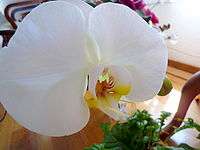
- Phalaenopsis gigantea (Borneo to Java).
- Phalaenopsis hainanensis (China - Hainan and Yunnan).
- Phalaenopsis hieroglyphica (the Philippines - Luzon, Leyte, Samar, Palawan, and Mindanao islands).
- Phalaenopsis hieroglyphica var. Alba
- Phalaenopsis honghenensis (China - Yunnan).
- Phalaenopsis inscriptiosinensis (Central Sumatra
- Phalaenopsis javanica (Western Java).
- Phalaenopsis kunstleri (Myanmar to Malaya).
- Phalaenopsis lamelligera (Northeastern Borneo).
- Phalaenopsis lindenii (the Philippines - Luzon island).
- Phalaenopsis lindenii var. alba
- Phalaenopsis lobbii (Eastern Himalayas to Myanmar).
- Phalaenopsis lowii (Southern Myanmar to western Thailand).
- Phalaenopsis lueddemanniana (the Philippines).
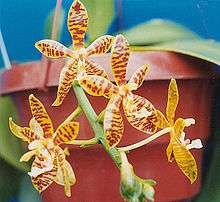
- Phalaenopsis luteola (Northwestern Borneo).
- Phalaenopsis maculata (Malaya to Borneo).
- Phalaenopsis malipoensis Z.J.Liu & S.C.Chen (China - Yunnan)
- Phalaenopsis mannii (Eastern Himalayas to China - Yunnan).
- Phalaenopsis mariae (Northeastern Borneo to the Philippines - Mindanao).
- Phalaenopsis micholitzii (the Philippines - Mindanao island).
- Phalaenopsis modesta (Borneo).
- Phalaenopsis mysorensis (Indian subcontinent).
- Phalaenopsis pallens (the Philippines - Luzon and Mindanao islands).
- Phalaenopsis pantherina (Borneo).
- Phalaenopsis parishii (Eastern Himalayas to Myanmar).
- Phalaenopsis petelotii (Vietnam)
- Phalaenopsis philippinensis (the Philippines - Luzon island).
- Phalaenopsis pulcherrima (Indochina to Borneo). Formerly classified as Doritis.
- Phalaenopsis pulchra (the Philippines - Luzon island).
- Phalaenopsis pulchra var. Alba
- Phalaenopsis regnieriana (Indochina).
- Phalaenopsis reichenbachiana (the Philippines - Mindanao island).

- Phalaenopsis robinsonii (the Moluccas).
- Phalaenopsis sanderiana (the Philippines - Mindanao island).
- Phalaenopsis sanderiana var. Alba
- Phalaenopsis sanderiana var. Marmorata
- Phalaenopsis schilleriana (the Philippines - Luzon, Mindoro, and Biliran islands).
- Phalaenopsis speciosa (Andaman and Nicobar Islands).
- Phalaenopsis stobartiana (China - southeastern Tibet to Guangxi)
- Phalaenopsis stuartiana (the Philippines - Mindanao island).
- Phalaenopsis sumatrana (Indochina, Borneo to Philippines - Palawan island).
- Phalaenopsis taenialis (Eastern Himalayas to China - Yunnan)
- Phalaenopsis tetraspis (Andaman and Nicobar Islands to northwestern Sumatra).
- Phalaenopsis venosa (Sulawesi).
- Phalaenopsis violacea (Malaya to Sumatra).).
- Phalaenopsis viridis (Sumatra).
- Phalaenopsis wilsonii (China - southeastern Tibet to Guangxi).
- Phalaenopsis zebrina (Borneo).
Natural hybrids
- Phalaenopsis × amphitrita (P. sanderiana × P. stuartiana; Mindanao - Philippines)
- Phalaenopsis × gersenii (P. sumatrana × P. violacea; Borneo, Sumatra)
- Phalaenopsis hieroglyphica × lueddemanniana (P. hieroglyphica x P. lueddemanniana; Philippines)
- Phalaenopsis × intermedia (P. aphrodite × P. equestris; Star of Leyte; Leyte - Philippines) (First recognized Phalaenopsis hybrid)
- Phalaenopsis × intermedia var. Diezii (P. aphrodite × P. equestris; Star of Leyte; Leyte - Philippines)
- Phalaenopsis × leucorrhoda (P. aphrodite × P. schilleriana; Luzon - Philippines)
- Phalaenopsis × rothschildiana (P. amabilis × P. schilleriana; Luzon - Philippines)
- Phalaenopsis x schilleriano-stuartiana (P. schilleriana × P. stuartiana; Leyte - Philippines)
- Phalaenopsis × singuliflora (P. bellina × P. sumatrana; Borneo)
- Phalaenopsis × veitchiana (P. equestris × P. schilleriana; Luzon and Leyte - Philippines)
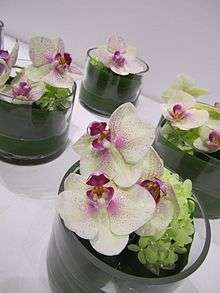
Intergeneric hybrids
The following nothogenera have been established for intergeneric hybrids which include species of Phalaenopsis as ancestors.
- ×Aeridopsis (Aerides × Phalaenopsis)
- ×Arachnopsis (Arachnis × Phalaenopsis)
- ×Asconopsis (Ascocentrum × Phalaenopsis)
- ×Beardara (Ascocentrum × Doritis × Phalaenopsis)
- ×Bogardara (Ascocentrum × Phalaenopsis × Vanda × Vandopsis)
- ×Bokchoonara (Arachnis × Ascocentrum × Phalaenopsis × Vanda)
- ×Cleisonopsis (Cleisocentron × Phalaenopsis)
- ×Devereuxara (Ascocentrum × Phalaenopsis × Vanda)
- ×Diplonopsis (Diploprora × Phalaenopsis)

- ×Doriellaopsis (Doritis × Kingiella × Phalaenopsis)
- ×Doritaenopsis (Doritis × Phalaenopsis)
- ×Dresslerara (Ascoglossum × Phalaenopsis × Renanthera )
- ×Edeara (Arachnis × Phalaenopsis × Renanthera × Vandopsis)
- ×Ernestara (Phalaenopsis × Renanthera × Vandopsis)
- ×Eurynopsis (Eurychone × Phalaenopsis)
- ×Hagerara (Doritis × Phalaenopsis × Vanda)
- ×Hausermannara (Doritis × Phalaenopsis × Vandopsis)
- ×Himoriara (Ascocentrum × Phalaenopsis × Rhynchostylis × Vanda)
- ×Isaoara (Aerangis × Ascocentrum × Phalaenopsis × Vanda)
- ×Laycockara (Arachnis × Phalaenopsis × Vandopsis)
- ×Lichtara (Doritis × Gastrochilus × Phalaenopsis)
- ×Luinopsis (Luisia × Phalaenopsis)
- ×Lutherara (Phalaenopsis × Renanthera × Rhynchostylis )
- ×Macekara (Arachnis × Phalaenopsis × Renanthera × Vanda × Vandopsis)
- ×Meechaiara (Ascocentrum × Doritis × Phalaenopsis × Rhynchostylis × Vanda)
- ×Moirara (Phalaenopsis × Renanthera × Vanda)
- ×Nakagawaara (Aerides × Doritis × Phalaenopsis)
- ×Owensara (Doritis × Phalaenopsis × Renanthera )
- ×Parnataara (Aerides × Arachnis × Phalaenopsis)
- ×Paulara (Ascocentrum × Doritis × Phalaenopsis × Renanthera × Vanda)
- ×Pepeara (Ascocentrum × Doritis × Phalaenopsis × Renanthera )
- ×Phalaerianda (Aerides × Phalaenopsis × Vanda)
- ×Phalandopsis (Phalaenopsis × Vandopsis)
- ×Phalanetia (Neofinetia × Phalaenopsis)
- ×Phaliella (Kingiella × Phalaenopsis)
- ×Phalphalaenopsis (Phalaenopsis × Paraphalaenopsis
- ×Pooleara (Ascocentrum × Ascoglossum × Phalaenopsis × Renanthera )
- ×Renanthopsis (Phalaenopsis × Renanthera )
- ×Rhynchonopsis (Phalaenopsis × Rhynchostylis)
- ×Rhyndoropsis (Doritis × Phalaenopsis × Rhynchostylis)
- ×Richardmizutaara (Ascocentrum × Phalaenopsis × Vandopsis)
- ×Roseara (Doritis × Kingiella × Phalaenopsis × Renanthera )
- ×Sappanara (Arachnis × Phalaenopsis × Renanthera)
- ×Sarconopsis (Phalaenopsis × Sarcochilus)
- ×Sidranara (Ascocentrum × Phalaenopsis × Renanthera)
- ×Sladeara (Doritis × Phalaenopsis × Sarcochilus)
- ×Stamariaara (Ascocentrum × Phalaenopsis × Renanthera × Vanda)
- ×Sutingara (Arachnis × Ascocentrum × Phalaenopsis × Vanda × Vandopsis)
- ×Trautara (Doritis × Luisia × Phalaenopsis)
- ×Trevorara (Arachnis × Phalaenopsis × Vanda)
- ×Trichonopsis (Phalaenopsis × Trichoglottis)
- ×Uptonara (Phalaenopsis × Rhynchostylis × Sarcochilus)
- ×Vandaenopsis (Phalaenopsis × Vanda)
- ×Vandewegheara (Ascocentrum × Doritis × Phalaenopsis × Vanda)
- ×Yapara (Phalaenopsis × Rhynchostylis × Vanda)
- ×Yeepengara (Aerides × Phalaenopsis × Rhynchostylis × Vanda)
Post-pollination changes in Phalaenopsis orchids
Phalaenopsis are unique in that in some species, the flowers turn into green leaves after pollination. As in many other plants, the petals of the orchid flowers serve to attract pollinating insects and protect essential organs. Following pollination, petals will usually undergo senescence (i.e. wilt and disintegrate) because it is metabolically expensive to maintain them. In many Phalaenopsis species, such as P. violacea, the petals and sepals find new uses following pollination, thus escaping programmed cell death. In producing chloroplasts, they turn green, become fleshy and apparently start to photosynthesize, as leaves do.[8]
Growing Phalaenopsis
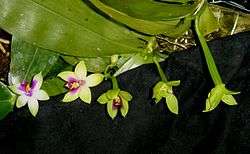
Phalaenopsis are among the most popular orchids sold as potted plants, owing to the ease of propagation and flowering under artificial conditions. They were among the first tropical orchids in Victorian collections. Since the advent of the tetraploid hybrid Phalaenopsis Doris, they have become extremely easy to grow and flower in the home, as long as some care is taken to provide them with conditions that approximate their native habitats. Their commercial production has become an industry.
In nature, Phalaenopsis species are typically fond of warm temperatures, thriving in temperatures around 20 to 35 °C (68-95 °F), but are adaptable to conditions more comfortable for human habitation in temperate zones (15 to 30 °C or 59 to 86 °F); at temperatures below 18 °C (64.4 °F) overwatering causes root rot. Phalaenopsis requires high humidity (60-70%) and low light of 12,000 to 20,000 lux. However, Phalaenopsis orchids can adapt to the lower humidity found in most homes. They are also typically hardier than other species of orchids, and this makes them particularly popular among first-time orchid growers.[9]
The flower spikes appear from the pockets near the base of each leaf. The first sign is a light green "mitten-like" object that protrudes from the basal leaf tissue. Over about three months the spike elongates until it begins to swell fat buds which will bloom.
It was previously believed that flowering is triggered by a night-time drop in temperature of around 5 to 6 degrees over two to four consecutive weeks, usually in the fall, and a day-time drop in temperature to below 29 °C (84 °F). Using two Phalaenopsis clones, Matthew G. Blanchard and Erik S. Runkle (2006) established that, other culture conditions being optimal, flower initiation is controlled by daytime temperatures declining below 27 °C (81 °F), with a definite inhibition of flowering at temperatures exceeding 29 °C (84 °F). The long-held belief that reduced evening temperatures control flower initiation in Phalaenopsis is shown to be false. Rather, lower daytime temperatures influence flowering, while night time temperatures do not appear to have any effect.[10]
Ecology
In Phalaenopsis, phenylpropanoid enzymes are enhanced in the process of plant acclimatisation at different levels of photosynthetic photon flux.[11]
References
- 1 2 Kew World Checklist of Selected Plant Families
- ↑ http://www.orchidsplus.com/phalaenopsis-moth-orchids/
- ↑ Flora of China v 25 p 478, 蝴蝶兰属 hu die lan shu, Phalaenopsis Blume, Bijdr. 294. 1825.
- ↑ Coombes, Allen J. (1994). Dictionary of Plant Names. London: Hamlyn Books. ISBN 978-0-600-58187-1. p. 140
- ↑ "Phalaenopsis Page". Internet Orchid Species Photo Encyclopedia. Jay Pfahl. Retrieved 29 June 2013.
- ↑ "How to Care for Orchids: A Comprehensive Organic Guide".
- ↑ "Phalaenopsis". World Checklist of Selected Plant Families. Royal Botanic Gardens, Kew. Retrieved 2012-04-10.
- ↑ Wouter G. van Doorn (October 2005). "Plant programmed cell death and the point of no return". Trends in Plant Science. 10 (10): 478–483. PMID 16153879. doi:10.1016/j.tplants.2005.08.003.
- ↑ Growing Conditions for Phalaenopsis Orchids, Accessed 11/11/2012
- ↑ Blanchard, Matthew G; Runkle, Erik S (2006). "Temperature during the day, but not during the night, controls flowering of Phalaenopsis orchids". Journal of Experimental Botany. 57 (15): 4043–4050. PMID 17075080. doi:10.1093/jxb/erl176.
- ↑ Mohammad Babar Ali, Serida Khatun, Eun-Joo Hahn and Kee-Yoeup Paek,, 2006. "Enhancement of phenylpropanoid enzymes and lignin in Phalaenopsis orchid and their influence on plant acclimatisation at different levels of photosynthetic photon flux". Plant Growth Regulation volume 49, Numbers 2-3, pages 137-146, doi:10.1007/s10725-006-9003-z
- Original publication by Carl Blume in "Bijdragen tot de Flora van Nederlandsch Indië"
- Seon Kim; Clifford W. Morden; Yoneo Sagawa & Jae -Young Kim (2003). "The Phylogeny of Phalaenopsis Species". Proceedings of NIOC2003, Nagoya, Japan.
- Olaf Gruss & Manfred Wolf - Phalaenopsis ; Edition Ulmer, ISBN 3-8001-6551-1 (in German)
- Eric A. Christenson - Phalaenopsis: a Monograph ; ISBN 0-88192-494-6
- Harper, Tom (February 2004). Phalaenopsis Culture: Advice for Growing 20 Species. Orchids Magazine 73 (2). Delray Beach, FL: American Orchid Society, 2004.
- Leroy-Terquem, Gerald and Jean Parisot. 1991. Orchids: Care and Cultivation. London: Cassel Publishers Ltd.
- Schoser, Gustav. 1993. Orchid Growing Basics. New York: Sterling Publishing Co., Inc.
- White, Judy. 1996. Taylor’s Guide to Orchids. Frances Tenenbaum, Series Editor. New York: Houghton-Mifflin, ISBN 0395677262
External links
| Wikimedia Commons has media related to Phalaenopsis. |
-
 Data related to Phalaenopsis at Wikispecies
Data related to Phalaenopsis at Wikispecies - Phalaenopsis orchids : species and primary hybrids
- Phalaenopsis orchid care instructions
- Open Directory Project Phalaenopsis Category